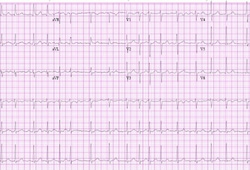Resumo
Definição
História e exame físico
Principais fatores diagnósticos
- irregular pulse rate
Outros fatores diagnósticos
- palpitations
- hypotension
- elevated jugular venous pressure
- added heart sounds
- dizziness
- dyspnea
- rales
- evidence of stroke
Fatores de risco
- increasing age
- hypertension
- orthostatic hypotension
- diabetes mellitus
- heart failure
- valvular and structural heart disease
- coronary artery disease and acute coronary syndromes
- other atrial arrhythmias
- sepsis and critical illness
- cardiac or thoracic surgery
- obesity
- hyperthyroidism
- hypoxic pulmonary conditions
- alcohol consumption
- smoking
- inflammatory disorders
- excessive exercise
- height
- cancer and chemotherapy
Investigações diagnósticas
Primeiras investigações a serem solicitadas
- ECG
- serum electrolytes
- cardiac biomarkers
- thyroid function tests
- CXR
- transthoracic echocardiogram
- transesophageal echocardiogram (TEE)
Tests to avoid
- coronary CT angiography
Investigações a serem consideradas
- electrophysiologic study
- exercise stress tests
Algoritmo de tratamento
hemodynamically unstable
hemodynamically stable with left atrial thrombus, or presence of thrombus unknown/duration of AF unknown
hemodynamically stable without left atrial thrombus: symptom onset <48 hours
hemodynamically stable without left atrial thrombus: symptom onset ≥48 hours
hemodynamically stable without left atrial thrombus: asymptomatic
Colaboradores
Autores
Arti N. Shah, MS, MD
Director
Cardiac Electrophysiology
Elmhurst Hospital Center
Elmhurst
Assistant Professor of Medicine
Mount Sinai School of Medicine
New York
NY
Declarações
ANS declares that she has no competing interests.
Bharat K. Kantharia, MD, FRCP, FAHA, FACC, FESC, FHRS
Clinical Professor of Medicine
Icahn School of Medicine at Mount Sinai
President
Cardiovascular and Heart Rhythm Consultants
Attending and Consultant Cardiac Electrophysiologist
Mount Sinai Hospitals
New York Methodist Hospital
New York
NY
Declarações
BKK declares that he has no competing interests.
Revisores
Diwakar Jain, MD, FACC, FRCP, FASNC
Professor of Medicine (Cardiology)
Westchester Medical Center
Valhalla
NY
Declarações
DJ declares that he has no competing interests.
Farooq A. Padder, MD, MRCP, FACC
Assistant Professor of Medicine
Hahnemann University Hospital
Woodbury
NJ
Declarações
FAP declares that he has no competing interests.
Kim Rajappan, MA, MD, MRCP
Consultant Cardiologist and Electrophysiologist
Cardiac Department
John Radcliffe Hospital
Oxford
UK
Declarações
KR declares that she has no competing interests.
Créditos aos pareceristas
Os tópicos do BMJ Best Practice são constantemente atualizados, seguindo os desenvolvimentos das evidências e das diretrizes. Os pareceristas aqui listados revisaram o conteúdo pelo menos uma vez durante a história do tópico.
Declarações
As afiliações e declarações dos pareceristas referem--se ao momento da revisão.
Referências
Principais artigos
Joglar JA, Chung MK, Armbruster AL, et al. 2023 ACC/AHA/ACCP/HRS guideline for the diagnosis and management of atrial fibrillation: a report of the American College of Cardiology/American Heart Association Joint Committee on clinical practice guidelines. Circulation. 2024 Jan 2;149(1):e1-156.Texto completo Resumo
Hindricks G, Potpara T, Dagres N, et al. 2020 ESC Guidelines for the diagnosis and management of atrial fibrillation developed in collaboration with the European Association for Cardio-Thoracic Surgery (EACTS). Eur Heart J. 2021 Feb 1;42(5):373-498.Texto completo
Artigos de referência
Uma lista completa das fontes referenciadas neste tópico está disponível para os usuários com acesso total ao BMJ Best Practice.

Diagnósticos diferenciais
- Atrial flutter
- Wolff-Parkinson-White syndrome
- Atrial tachycardia
Mais Diagnósticos diferenciaisDiretrizes
- 2023 ACC/AHA/ACCP/HRS guideline for the diagnosis and management of atrial fibrillation: a report of the American College of Cardiology/American Heart Association Joint Committee on clinical practice guidelines
- 2023 ACC/AHA/ACCP/HRS guideline for the diagnosis and management of atrial fibrillation: a report of the American College of Cardiology/American Heart Association Joint Committee on clinical practice guidelines
Mais DiretrizesFolhetos informativos para os pacientes
Atrial fibrillation: what is it?
Atrial fibrillation: what are the treatment options?
Mais Folhetos informativos para os pacientesCalculadoras
GARFIELD-AF
Atrial Fibrillation CHA(2)DS(2)-VASc Score for Stroke Risk
Mais CalculadorasVideos
How to perform an ECG: animated demonstration
Mais vídeosConectar-se ou assinar para acessar todo o BMJ Best Practice
O uso deste conteúdo está sujeito ao nosso aviso legal